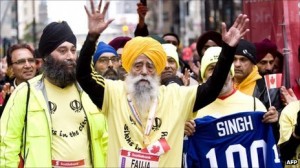At age 100, British runner Fauja Singh completed Sunday’s Toronto Waterfront Marathon in 8:25:16, placing 3,850 out of 3,855. Which means first that he is a phenomenal athlete and second that five people had to slink home after the race and admit they were beat by someone who was born the year Hiram Bingham discovered Machu Picchu.
This astonishing feat is timely in the way that all human triumphs over our stilted preconceptions is timely, and also because it feels like it’s been a bad year for fatal marathon heart attacks.
For the record, Singh—who is known as the Turbaned Tornado—attributes his stamina to avoiding tobacco and alcohol, staying positive and eating ginger curry. This seems reasonable (and delicious) but medical experts who actually understand what happens to the aging body are nevertheless in awe. Over time, the heart doesn’t work efficiently, muscles strength tapers off until age 70 (when it starts to drop like a 10-pound barbell you can’t lift anymore), and as the BBC kindly points out, tendons become brittle and lung tissue gets stiff.
Yet Singh went the distance in under 8.5 hours.
And he didn’t have a heart attack, which has happened with a certain frequency over the summer and fall. But as André Picard reports in Toronto’s Globe and Mail, “Donald Redelmeier, a professor of medicine at the University of Toronto, examined records from marathons where there were 3.3 million participants over a 30-year period. There were 26 deaths. That’s a death rate of one in 126,000 – roughly the same as the death rate in the general population. Stated plainly, people die of heart disease, not running. (And, to repeat, being fit reduces the risk of heart disease substantially.)”
Picard adds that a marathon is a good place to have a heart attack if your number comes up. Because of all the paramedics and equipment ranged along the race course, roughly three-quarters of the people who have a marathon heart attack survive; your odds are much lower—just a 15 percent likelihood of survival—if you’re sitting on the couch watching, let’s say, Survivor.
To be honest, we are not consoled. We would like to see statistics that focus on the cardiac risks for older people—let’s say, anyone over 50—who run marathons. The fact is, running 26 miles is brutal on your joints, your heart and your muscles. And any sport that makes your nipples bleed needs to be approached with caution. If you’re aging, the damage is going to be that much greater. At some point, the risks go up, and you should start asking yourself deep questions about why you’re doing it.
But then you look at Fauja Singh and think, awesome. (Here’s how awesome: he didn’t start running until he turned 89.) And the fact is, the people who die from marathon heart attacks don’t seem to be old. It’s often, and tragically, someone much younger who had an undetected condition. So screw it. Get your affairs in order and strap on your shoes. You’re young. Compared to Fauja Singh, you’re a whelp.
UPDATE: The records keep falling. Earlier this month, Harold Bach of Dickinson, ND, became the fastest man alive who is at least 90 years old. He set a new world record for his age group at the Huntsman World Senior Games in St. George, Utah, finishing the 50-meter race in 10.95 seconds. He is 91. Kudos, Harold.
Photo via BBC










